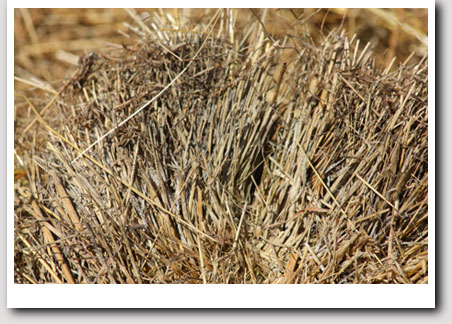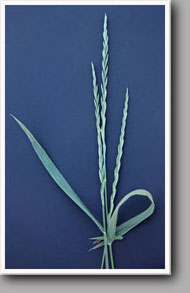So What can I do about it?
Simply put - minimise exposure and feed a toxin binder.
Never feed mouldy hay.
The white dust that fluffs out of hay that has been baled with too much moisture content is the very dangerous Aspergillus fungus. If inhaled by you or the horse it can set up camp in the guttural pouches or the lungs and cause serious respiratory problems.
Ensure hay is thoroughly dried prior to baling and stored in a dry environment.
Inspect all feeds for possible moulds, sometimes they are visible but often there will be a musty smell.
Feed a Toxin Binder
This has become routine now for horse owners in New Zealand and word is now spreading in Australia.
There are two different classes of toxin-binders available:
Inorganic:
These are the clays, zeolite, bentonite, alumina-silicates. They all require a comparatively high dose rate
They are structured in layers with a negative charge attracting positive charges thereby binding them up. They are normally cheaper but the downside is that they also bind the ‘goodies’ including copper, zinc, calcium, magnesium and if anti-biotics are there they will bind these too. This can significantly reduce mineral utilisation.
Clays are good at binding aflotoxins found in corn crops and peanuts and sodium bentonite is good at binding ammonia. Clays can be contaminated with cadmium and dioxins
Organic:
Consist of modified yeast cell wall and involve live microbes and enzymes to denature the toxin.
‘Mycosorb’ patented by Alltech, is the most broad-spectrum toxin-binder (including aflotoxins)
It is derived from the inner portion of the yeast cell wall which contains both gluco-mannan and beta D-mannan combined with a small portion of alumina-silica. There is a synergistic effect of combining these two elements and this is patented.
Mycosorb has a helical or spiral structure which has an incredibly vast surface area.
1gm of Mycosorb has 2 hectares of surface area, therefore it works at a very low dose rate. It can handle the wide range of pH throughout the intestine and has excellent capacity to mop up high concentrations of myco-toxins.
The Mycosorb particles are too large to pass thru the intestinal wall. Therefore animals cannot become ‘immune’ to toxin-binders as they do not enter the bloodstream.
They merely pass thru the digestive tract doing their job and exiting with the manure. People report feeding the toxin-binder dose twice a day during times of high myco-toxin exposure like autumn works better than once per day. This ensures more even presence throughout the 24 hour period.
There is no point in feeding more than 20-30gms at a time. It is a waste of money and will do no more good than the normal dose rate.
Grasses to Avoid
Perennial Rye-Grass
Rye grass harbours ‘endophyte’ fungi which produce myco-toxins under certain conditions, mainly those of spring and autumn. The endophytes grow up as the plant grows and collects in the seed-head so that the next plant will also contain endophytes. Mycotoxin production increases with rising temperatures and seed-head development of the plant in summer and then again in Autumn.
myco-toxins under certain conditions, mainly those of spring and autumn. The endophytes grow up as the plant grows and collects in the seed-head so that the next plant will also contain endophytes. Mycotoxin production increases with rising temperatures and seed-head development of the plant in summer and then again in Autumn. Whatever myco-toxins were present in the grass when it was baled will remain in the hay made from that grass.
It is important to understand that endophytes and their myco-toxins are ‘on the plant’s side’. In particular they deter insects from eating the grass. They therefore help protect the grass from insect damage and grazing by herbivores thereby increasing the grass’s chance of seeding and reproducing.
It is well known that in late summer/Autumn the rye-grass endophyte produces Lolitrem B, a mycotoxin which affects the CNS (Central Nervous System) of livestock consuming it. Livestock become un-co-ordinated, staggering in their hind-quarters, sometimes even falling over. It is like they are drunk. Of course they are accident prone when affected and liable to fall into fences or ditches.
Affected horses should be yarded on ad lib rye grass-free hay to keep them safe and allow their system to clean out of the toxins. They usually fully recover over a week – 10 days.
The other major myco-toxin produced by the endophytes in the rye-grass is called ‘ergovaline’. It is equally, if not even more harmful as it has a vaso-constricting effect on blood vessels to various organs. It is well known to cause ‘heat stress’ in livestock. Horses can be seen sweating just out on the paddock when it isn’t even particularly hot and they have not been exercising at all.
If the vaso-constriction happens to the uterus then it can cause abortions, if it happens to parts of the intestine then it causes ‘hind-gut necrosis’ ie death of a section of the digestive tract which of course manifests as serious, usually fatal colic. (I have heard of a horse that was successfully operated on, where the dead section was removed and the horse recovered).
Make it your business to be able to recognise these grasses. Rye-grass is easily identified by it’s dark green long, narrow leaves which are shiny on the back and also by it’s long, narrow seed-head with alternately arranged seeds on either side.
What about ‘Zero-endophyte’, ‘Novel endophyte’ or ‘Low-endophyte’ rye-grass?
These are Rye-grasses that have been artificially modified to either eliminate the endophytes altogether (Zero-endophyte) or just the most toxic endophytes while retaining the less toxic ones (Low-endophyte) for protection against insect damage to the grass.
None of them are suitable for horses!
All rye-grasses are “Skull & Cross-Bones” for horses. I cannot emphasise this enough.
Rye-grasses are meant for rapid weight-gain and milk production in commercial livestock which do not have a long lifespan.
We do not keep horses to fatten them for consumption or harvest their milk and we would like them to have a useful life for 30 or so years. There are multiple reasons why rye-grass causes serious health and behaviour problems in horses even when the endophytes have been removed.
They are
- Prone to serious mineral imbalances
- Too high in NSC’s
- Store their sugars as indigestible fructans
- High in fluorescing pigments.
Paspalum
Paspalum in New Zealand and Australia can become a dominant grass in warmer regions, particularly during summer and autumn when most other grasses will have browned off.
The problem is that Paspalum harbours a fungus called Paspalum Claviceps manifesting on the seed-head as ‘ergots’ (which resemble mouse droppings). Ergots are chokka full of chemicals known as toxic alkaloids: The Paspalum ergot ONLY affects the flower/seed-head, NOT the rest of the grass. Roots, stem and foliage are free of this fungus and safe for livestock to eat.
These little black Ergots drop to the ground where they overwinter. Under the right weather conditions, (moist and cool mostly) they produce spores (conidia), which get carried by the wind onto flowering seed heads. There they infect the grass flower, and produce first "honey dew", a white frost like layer of millions of new spores (conidia), which get carried off by the wind to infect more flowers. The purpose is to infect as many other plants as possible in the same summer season. Then, the fungus produces a new ergot which falls onto the ground again, and overwinters there.
So, as long as there are no seed heads on the Paspalum it is safe. Once seed heads are out, and flowering has started, the fungus can be there and busy growing inside the flowers already.
The challenge with Paspalum is to keep it from flowering! If it is mowed it merely develops a seed-head on a shorter stem.
These ergots may also develop on a variety of pasture grasses and hay, including ryegrass and bluegrass. These toxins are chemically related to LSD and cause loss of co-ordination or ‘staggers’ along with hallucinations.
References
Ryegrass Endophyte: An Up-to-Date Review of its Effects
P.V. Rattray June 2003
Aflatoxins and Other Mycotoxins
H. E. Duncan and W. M. Hagler, Jr. (North Carolina State University) - Oklahoma Cooperative
PUBLICATION DATE: 09/12/2008
 Calm Healthy Horses
Calm Healthy Horses